Solution for a student need
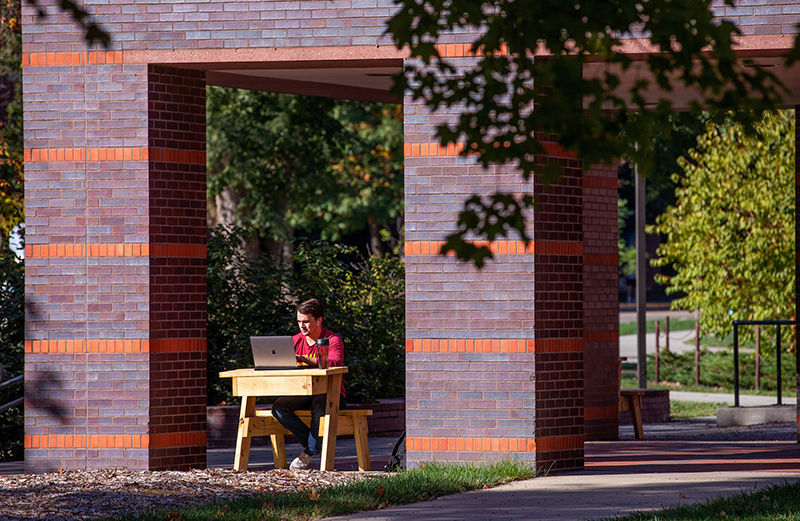
Photo by Christopher Gannon.
Senior industrial engineering major Joe Gibbons soaks up some October morning sun while working at a student desk outside the Black Engineering Building last week. His study desk was designed by senior mechanical engineering major Juliana "Jana" Camaioni, who received help from classmates to assemble a set of 11 installed near the south doors to Black Engineering and in the building's lower courtyard.
When the mechanical engineering department sought ways last year to increase outdoor seating options to deter the spread of COVID-19, Camaioni answered the call. She combined the design knowledge gained through engineering courses with the fabrication skills she developed working as a student technician in the department's Boyd Lab to create college student-sized desks, modeled after a simple design for a child's desk. Her aim was to create study spaces that didn't "waste the six feet of lumber between them at a traditional picnic table."
An initial set was completed late last spring, with more added this fall.
A closer look at how WorkFlex will work
With the release of detailed guidelines and a live seminar this week, employees got a more in-depth look at a new program that offers ISU staff flexibility in when, where and how they work.
For more information
To review all of UHR's guidance and resources on WorkFlex, visit the program's website. A recording of the Oct. 19 seminar is available in Learn@ISU. Log in with your Net-ID and search the keyword FY22-02.
While the options it provides may have been available in the past, the WorkFlex program first announced earlier this month formalizes a consistent process for proposing, considering and approving such arrangements, university human resources (UHR) benefits and WorkLife director Ed Holland said in an Oct. 19 virtual seminar hosted by the Professional and Scientific Council.
When it fits an employee's job duties, a unit's needs and Iowa State's mission, WorkFlex will allow employees to work remotely up to three days a week, adapt their schedule to work at different times of the day, adopt a compressed work week of fewer but longer days, or work part-time. The program is for staff only because faculty schedules are already flexible.
Offering flexibility to eligible staff has long been a goal, but it took on greater urgency after the COVID-19 pandemic made remote working and adjusted schedules more mainstream, Holland said in the seminar. There are numerous benefits for both employees and the institution.
"We see this as very valuable to the university going forward," he said.
Based on resources UHR released on the WorkFlex website and comments from Holland and associate vice president for human resources services and strategy Dwaine Heppler during the seminar, here's a breakdown of how the program will work.
Proposing a plan
Requests for the first round of WorkFlex arrangements, which will be effective at the start of the spring semester Jan. 18, can be submitted Nov. 1-26. Interested employees should think through their preferences, including the implications for their work teams and clientele, and discuss their perspectives and possible solutions with their supervisor.
UHR's employee guidance provides numerous questions to mull before requesting flexible work, including issues specific to each potential option. Employees who decide to pursue the program will submit an application through Workday similar to this draft form. Staff will need to outline their plans, estimate the impact on customer service and colleagues, and make a "business case" for why the arrangement would benefit the university and an employee's unit.
It's important that staff try to understand where their colleagues and supervisor are coming from as they approach WorkFlex discussions, which is part of the reason the WorkFlex website includes guidance for both employees and supervisors, Holland said.
Employees can work with their HR delivery team if they have questions as they develop their proposal or would like a review of their request.
Deliberate consideration
Supervisors will consider WorkFlex requests after the application window has closed and will have about a month to make decisions. The deadline for the initial round of applications is Dec. 23.
The deliberate process avoids a first-come, first-served approach. Ensuring supervisors have enough time to fairly consider requests was one of the biggest concerns from both staff and managers, based on feedback UHR received while developing WorkFlex, Holland said.
"That's why the program is being rolled out the way it is," he said.
UHR's guidance for supervisors recommends discussing WorkFlex as a team to encourage clear and fair decisions. Topics for a team to cover include setting coverage schedules, identifying core hours when all employees are available, determining what meetings or activities need to be in-person, setting protocols for changes and requests, and establishing online collaboration and communication methods.
Approval process
When considering WorkFlex requests, UHR's guidance directs supervisors to examine five components, which also are outlined in an assessment form:
- Business need/benefit
- Position suitability
- Employee suitability
- Supervisory conditions
- Team effectiveness
After supervisors review requests and approve proposed arrangements with employees, the respective staff appointing authority must sign off on requests to ensure they support unit goals and the university's mission. An appointing authority is an administrator who is able to hire employees under university policy. For staff, that could be a department chair, director, dean, associate provost, vice president, senior vice president or the president.
A flow chart illustrates the routing process for a WorkFlex request. Some departments may require requests to receive higher-level approval, Holland said.
If the request is approved, an employee and their supervisor will sign an agreement outlining the details of the arrangement. A draft agreement for hybrid work includes provisions related to matters such as university equipment and property, performance and remote workspace expectations, leave policies and workplace safety.
Addressing concerns
If an employee thinks their request hasn't been evaluated fairly, the first step is an informal conversation with their supervisor. If the situation remains unresolved, consult with HR delivery.
If a dispute can't be resolved informally, both merit and professional and scientific staff can review formal grievance processes to determine if that is an option. Formal written grievances are reviewed for eligibility before they can proceed through the grievance process.
Though there likely will be discussion among college and unit leaders about how to fairly weigh requests, the widely varying workplaces across campus likely will lead to some differences in how requests from similar positions are handled, Heppler said.
"What may work in one department might not work in another department," he said.
Answers to numerous possible concerns and questions related to WorkFlex are collected in an FAQ.
Looking forward
A new round of WorkFlex requests will be accepted three times a year, before the start of the fall, spring and summer sessions. The next round, for instance, is expected to open for applications March 7 for arrangements effective May 16, the first day of the summer term.
For new hires or staff who have an unexpected change between application periods, temporary flexible work arrangements less than three months long can be used, Holland said. Staff whose requests are denied also can apply in future application periods. Approved agreements will need to be renewed annually.
Though full-time remote work isn't allowed yet, it may be possible at some point. Before considering a fully remote option, senior leaders want to assess employee satisfaction and productivity in two units currently running remote work pilot studies, Heppler said.
That evaluation will extend into the spring semester, he said.
ISU's next strategic plan could resemble a 'to-be' list
The next university strategic plan will look and feel different than past plans.
Peter Dorhout, vice president for research who is chairing the steering committee for the next effort, said, "President [Wendy] Wintersteen has charged us to create something that those who come after us will point to and say, 'Now there was a defining moment for Iowa State University. That's when things really took off.'"
The current five-year strategic plan ends in 2022. The next plan may cover a nine-year period, from 2022 to 2031, and the effort may be realized as more of a strategic "process" than a "plan," Dorhout said. The goal is to have the new nine-year plan ready to be presented to the state Board of Regents before the end of spring semester 2022.
"President Wintersteen wants a plan that's more of a living document, in ways similar to how the university must be responsive to changing times," Dorhout said. "The previous strategic planning effort could never have envisioned how a university would need to keep moving forward in the face of a global pandemic. It's why our new plan should really be a strategic process in which we are nimble and capable of responding to future opportunities and challenges, to focus on excellence."
Joining Dorhout on the steering committee are:
- Jonathan Wickert, senior vice president and provost
- Pam Elliott Cain, senior vice president for operations and finance
- Toyia Younger, senior vice president for student affairs
- Larissa Holtmyer-Jones, president and CEO, ISU Foundation
- Andrea Wheeler, president, Faculty Senate, and associate professor, architecture
- Chris Johnsen, president, Professional and Scientific Council, and manager, Extension and Outreach distribution
Karen Bramow, project manager with the office of the vice president for research, will serve as strategic plan project manager.
Developing the plan
The steering committee held an organizing meeting Oct. 8, led by a charge from Wintersteen.
"President Wintersteen charged us to focus less on what Iowa State should do and more on what Iowa State should be in the future," Dorhout said. "So, we envision that we will be developing a 'to be' list rather than a 'to do' list. In that way, it will be as much a process as it is a plan.
"Our initial thinking is that we would build in regular reviews during the nine-year period of the new plan in which to take the pulse of the process and adjust direction or priority if needed."
A set of core values will be part of the new plan.
"It is essential to state these upfront to inform what comes next and to serve as threads that weave throughout the processes," Dorhout said.
The steering committee is beginning to lay the groundwork for the next plan. Its members are setting up working groups that will flesh out a development process and provide opportunities for input from the campus community and external stakeholders. It is expected that town hall meetings, both virtual and in person, and online surveys will be part of the mix.
Each working group will center around themes or "pillars" of the plan. The pillars still are under refinement, but are likely to focus on students, engagement, innovation and discovery.
"Throughout the nine years, we envision creating a timeline made up of significant success stories that illustrate progress towards what we are striving to be as a 21st century land-grant university -- one that provides access to excellence," Dorhout said.
Sirna named to equal opportunity interim leadership post
Mary Howell Sirna, administrative advisor and attorney on staff for ISU Police, will serve as the university's interim director of equal opportunity and Title IX coordinator, effective Oct. 25. President Wendy Wintersteen announced the appointment Oct. 20 and said a national search will be launched soon.
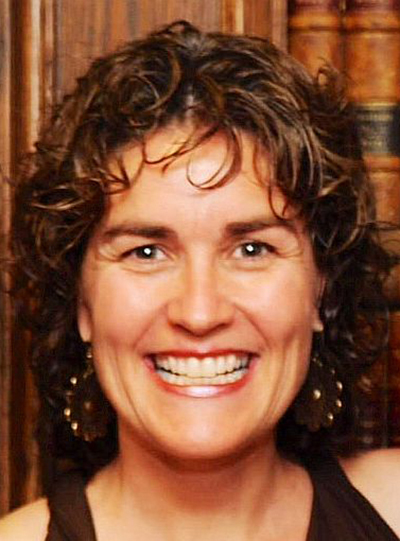
Sirna
Sirna previously served in this interim role at Iowa State from October 2015 to April 2016.
"Mary's experience at Iowa State University and deep knowledge of equal opportunity, anti-discrimination and affirmative action policy make her well-suited for this important interim role," Wintersteen said. "I am confident she will be an effective leader in working with the team to investigate complaints of discrimination and sexual misconduct, ensure compliance with the law and provide related educational programs to campus."
Sirna joined the university police department in January 2013. Previously she served as first assistant county attorney in the Story County attorney's office, and currently manages the Story County Sexual Assault Response Team (SART).
Sirna earned a bachelor's degree in political science and theatre arts from Mount Holyoke College, South Hadley, Massachusetts, and a law degree from the University of Iowa.
Wintersteen also announced that the reporting line for the office of equal opportunity will return to the office of the president. For several years, the first report was to the vice president for diversity, equity and inclusion. The change, she said, helps align the office's compliance responsibilities and critical role in supporting faculty, staff and students.
Start Something gives structure to college innovation and entrepreneurship efforts
The next few months will see the emergence of the Start Something network, the portfolio of college-based academic offerings designed to bring out the innovator in every Iowa State student.
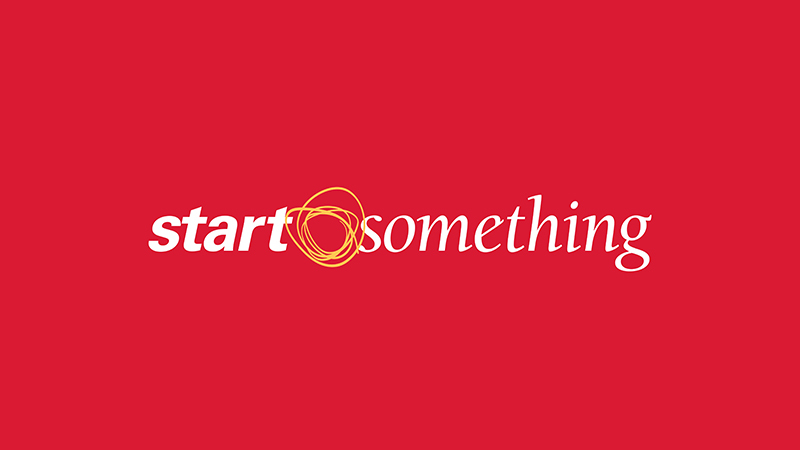
The Start Something network is a key element in demonstrating Iowa State's commitment to leadership in innovation and entrepreneurship education -- and strengthening the culture of Innovate at Iowa State.
"The Start Something network will be an important means of positioning the university as a go-to place in higher education for experiential learning, collaboration and instilling an entrepreneurial mindset focused on problem-solving," said President Wendy Wintersteen.
Start Something's academic opportunities include for-credit courses, capstone projects, internships and more. It will encompass existing programs within the colleges and new or emerging programs.
The combination of college-specific programs in the Start Something network and universitywide resources, such as the Student Innovation Center and Pappajohn Center for Entrepreneurship, will support and encourage student creativity. Some opportunities will be disciplinary and others interdisciplinary.
"Bringing together these offerings, packaged under the umbrella of Start Something, will make it easier for students to readily recognize the interconnectedness of innovation and entrepreneurial programs across campus," said Jacy Johnson, associate vice president for strategic relations and communications. "Under the strength of a common name, every college pursues a specialized take on innovation and entrepreneurship, tailored to the needs and interests of its students."
Sweeping upgrade equips all general classrooms with video
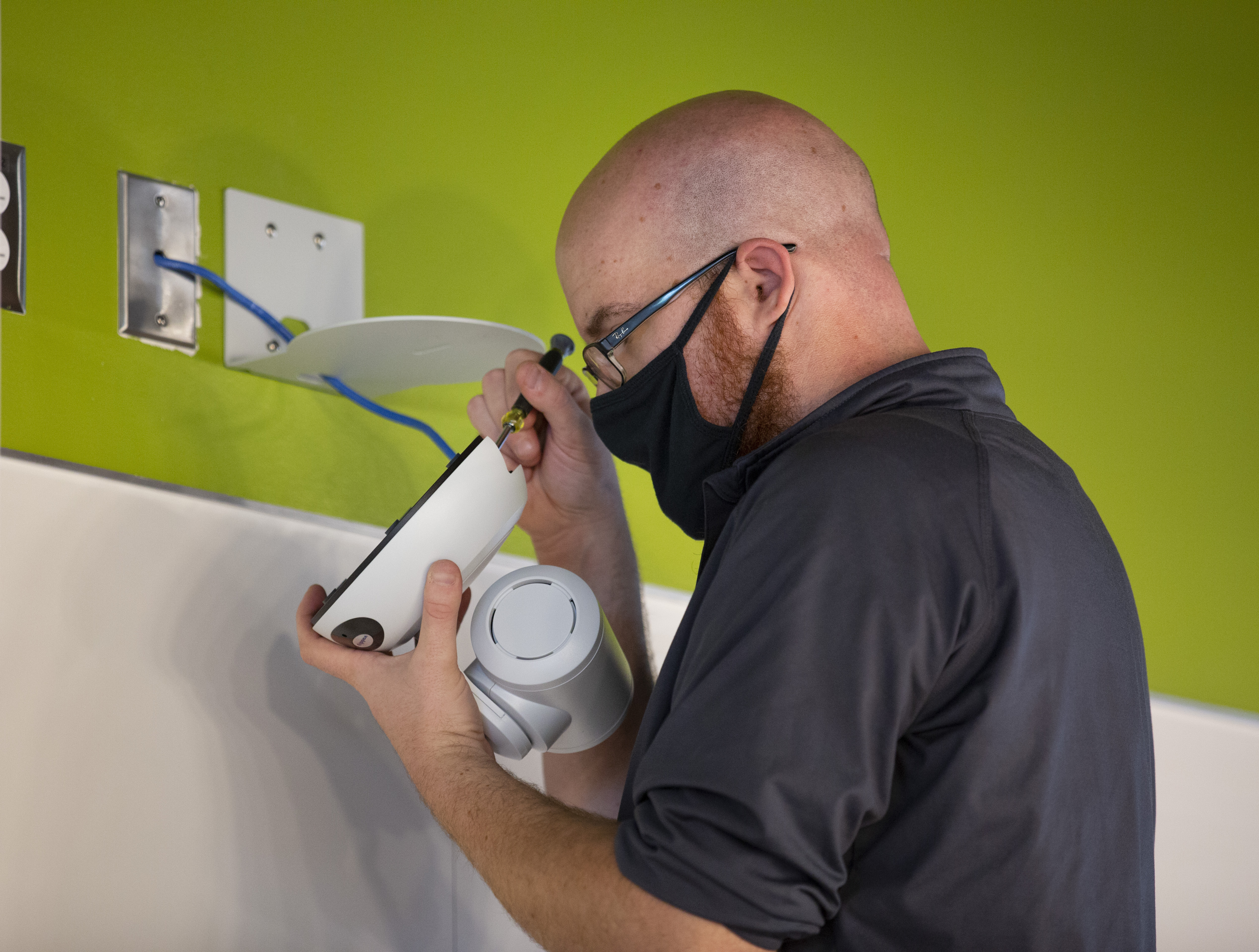
IT Services employee Phil Kuhlman installs a new camera in a classroom inside the Advanced Teaching and Research Building last fall. Photo by Christopher Gannon.
Before the pandemic, only 17 of Iowa State's largest classrooms were outfitted to record and livestream audio and video. As of this fall, all 214 general university classrooms have a video camera system, a rapid adoption of lecture capture technology that's especially useful for hybrid and virtual instruction.
The campuswide push to equip classrooms for video began in the summer and fall of 2020, as the information technology services (ITS) audiovisual experience team scrambled to outfit the general university classrooms large enough to be used despite pandemic-driven capacity limitations. That work continued this summer, when ITS installed camera systems in the 67 remaining smaller classrooms that returned to service this fall.
"This effort got us to the point where every general university classroom on campus has some form of hybrid or lecture capture technology," said Mike Pedersen, ITS audiovisual experience manager.
While increased reliance on online teaching last year lent the project a more immediate urgency, the desire to put cameras in more classrooms predates COVID-19, Pedersen said.
"We had already been planning for this in the largest spaces. The pandemic just dramatically accelerated that process," he said.
Two levels
The majority of classrooms feature a basic setup ITS refers to as level two, with a wide-angle camera and a microphone installed at the room's teaching station. Instructors can connect a laptop to use videoconferencing or recording software.
In larger classrooms, ITS installs the more sophisticated level one system that includes a remote-control camera with pan, tilt and zoom capabilities and integration with existing handheld or lapel microphones used for in-room amplification.
ITS maintains an online list of which system is installed in each general university classroom. Forty-three classrooms currently have the more sophisticated technology, and upgrades planned over the upcoming winter and summer breaks will extend the level one system to 11 more classrooms. The level-one expansion will ensure all 31 general university classrooms with a capacity of more than 100 have the higher-end equipment.
Instructions for using the systems are affixed to classroom teaching stations and available online for both level one and level two.
Departmental rooms
The majority of large classrooms are general university spaces, but department-controlled space does represent a sizable share of ISU's classroom inventory. Of classrooms with a capacity above 50 people, 63 are departmental compared to 87 general university rooms.
It's not clear how many departmental classrooms are furnished with video systems, but Pedersen said he knows it's a common consideration in department-funded projects.
"I don't know how much effort is going in to retrofit classrooms, but I suspect as rooms are refreshed or constructed it will be a standard expectation," he said.
Refreshing planned
Expansion of classroom video capacity last summer and during the upcoming winter and summer breaks was funded by a grant from the Committee on the Advancement of Student Technology for Learning Enhancement (CASTLE), which recommends how to use money collected by student technology fees.
The CASTLE grant to ITS also paid for overall audiovisual upgrades in 35 classrooms, including new projectors, document cameras, touchscreen control panels, and HDMI and Solstice connectivity. That work is planned for this summer, including clusters of classrooms in Gilman Hall (10 rooms), Gerdin Business Building (7) and Physics Hall (6).
Two of the largest rooms on the list for an audiovisual refresh this summer are 101 Design and 101 Carver, auditoriums that hold more than 200 people. Facilities planning and management also will be refreshing those rooms this summer, including new seats and carpet, Pedersen said.
"We'll be making some good headway on keeping our classrooms current and up-to-date," he said.
Cyclone homecoming spirit
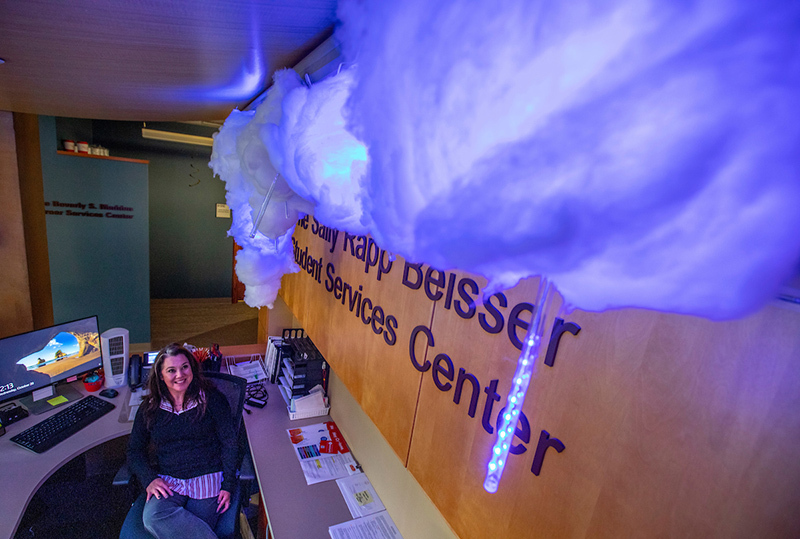
Photo by Christopher Gannon.
Shelina Ashlock, a student services coordinator in the College of Human Sciences, admires her team's decorating efforts this Homecoming week. Storm clouds, complete with thunder bolts, adorn the college's student services center, their entry in this year's office decorating contest. The theme for Homecoming 2021 is "Cy of the Storm." Judging occurs later this week.
Faculty, staff have an important role in student well-being
The need to support students' mental health is evident on college and university campuses across the nation. Returning to campus, in-person instruction and more frequent social interactions have added stress for students on top of challenges the pandemic presents.
Supporting our students
An Oct. 18 memo from senior vice presidents Jonathan Wickert and Toyia Younger and Faculty Senate president Andrea Wheeler outlines ways faculty and staff can support students' mental health needs.
Mental health concerns among college students increased before the pandemic and were exacerbated by it, said Kristen Sievert, interim director of student counseling services. Iowa State faculty and staff play a role in supporting the well-being of students by creating a community of care.
"The level of crises that we are seeing coming into the counseling center is far greater than previous years," she said. "Students have significant concerns about the ability to keep themselves safe, and we see an increase in the complexity or severity of what students are dealing with."
Providing support
Sievert said faculty and staff are in a unique position to provide support.
"When they notice a student is struggling, they can reach out and share their observations, express care and share resources," she said.
Validating a student's feelings and recognizing it is a trying time can be an important step, Sievert said. Students may have financial pressure or have lost a loved one because of the pandemic.
Being able to spot signs a student is struggling is key. Changes in mood or behavior from how instructors typically view a student can be signs. Showing up late for class or declining work quality can indicate a larger issue.
"Students expressing things like hopelessness or worthlessness or saying things like, 'What is the point of all of this anyway' or 'I can't keep doing this,' are signs," Sievert said.
Michelle Roling, student counseling services associate director and outreach director, said group work can cause more anxiety for students in the classroom. Instructors asking students to reach out to them if they have concerns about group work can make a difference.
Many instructors include student health and wellness language in their class syllabi, but Sievert said it's important to return to it numerous times throughout a semester.
"Students are getting so much information at the beginning of a semester, so it is helpful to share things multiple times," she said.
Offering assistance
Faculty or staff who notice a student dealing with an issue shouldn't hesitate to engage them.
"We want kindness, and we want people to be direct," Roling said. "We want to come from a place of 'I am noticing' or 'I am curious about.' Mental health has so much stigma and so many people don't want to talk about it that often it is a relief if someone names it for a student."
The goal is to get students to say what they are concerned about, inform them of options and encourage them to use them. Helping students identify what support looks like can help them connect with the right resources. That can be counseling or simply taking time to talk to a parent or loved one to reconnect with a support system, Roling said.
If the situation could involve a student hurting themselves or others, walking with them to a resource on campus may be necessary for their safety.
"You are not expected to be a mental health provider when you reach out to a student," Sievert said. "You don't have to have all the answers or worry about saying or doing just the right thing."
Helpful tools
Iowa State has many wellness resources available to students, but two are set especially to a student's daily pace.
Therapy Assistance Online is a free, confidential self-help tool that navigates mental well-being. The interactive sessions help people gain self-awareness to achieve their goals. It is available to everyone with an @iastate.edu email address.
Let's Talk is a confidential space for students to meet briefly with student counseling services staff without committing to ongoing counseling. It is located in the Multicultural Center in the Memorial Union on Mondays and Tuesdays from 3 to 5 p.m. It's first come, first served.
Roling said it's important for faculty, staff and students to remember to meet their basic needs of food, drink and rest each day to enhance their mental health.
Self-care
Faculty and staff are important in helping students, but equally important is that they take care of themselves.
"You can't help others if you don't have the self-care piece," Sievert said.
Finding small amounts of time throughout a day to support mental health -- for example, taking a walk outside -- can have a significant impact, she said.
Setting limits and boundaries is necessary. Understand you are not the only one trying to help, she added.
IRS clarifies taxable income cap for dependent care expenses
Some provisions in federal COVID relief legislation created confusion about reimbursement limits for the Dependent Care Assistance Program. Earlier this year, the Internal Revenue Service clarified those amounts in its Notice 2021-26.
Under normal circumstances, employees may be reimbursed up to $5,000 per calendar year (up to $2,500 for married filing separate) without including it in their taxable income. If an employee has funds left over and takes advantage of the following year's grace period, any amount reimbursed during that grace period above $5,000 for the year must be reported as taxable income.
IRS Notice 2021-26 provides an exception to this rule. Any unused funds from 2020 that carry over into 2021 -- or unused funds from 2021 that carry over into 2022 -- will not count toward the annual maximum that may be reimbursed on a tax-favored basis.
An example: An employee elected $5,000 for plan year 2020 but did not incur any childcare expenses. The full unused $5,000 carried over for use in 2021. The employee then elected to contribute the maximum $10,500 for plan year 2021. The employee incurs $15,500 in expenses and is reimbursed $15,500 in 2021. The full $15,500 is excluded from the employee's 2021 taxable income per IRS guidelines. Similarly, if an employee elects to contribute the full $5,000 maximum for plan year 2022, they may be reimbursed $5,000 plus any additional amounts that carried over from 2021 without increasing their taxable income.
Questions about flex plan rules and tax impacts may be directed to the payroll, benefits and tax office, fbac@iastate.edu.
U.S., Mexico ag secretaries meet on campus
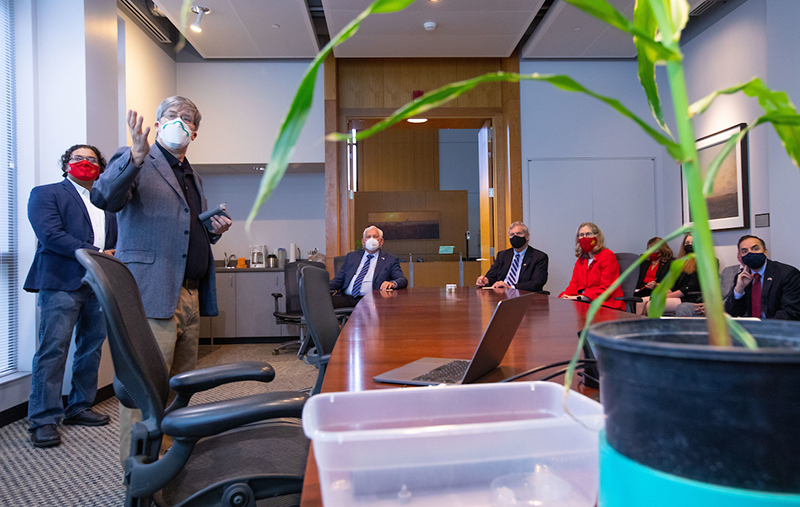
Pat Schnable (second from left), director of the Plant Sciences Institute, accompanied by Baskar Ganapathysubramanian (far left), a faculty scholar of the institute, makes a short presentation as part of a tour of the institute. Photos by Christopher Gannon.
Coinciding with World Food Prize events in Des Moines this week, the U.S. and Mexico agriculture secretaries traveled to Iowa State for a few hours Oct. 20 for a bilateral meeting and a tour that included the Seed Science Center and the Plant Sciences Institute. Mexico's secretary of agriculture and rural development Víctor Manuel Villalobos Arámbula and U.S. secretary of agriculture Tom Vilsack were scheduled to participate Thursday on World Food Prize panels.
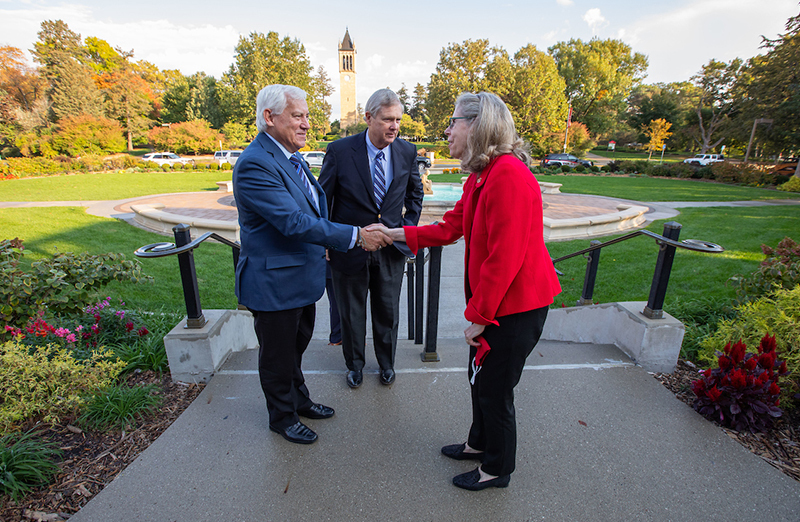
President Wendy Wintersteen welcomes to campus Mexico's Secretary of Agriculture and Rural Development Víctor Manuel Villalobos (left) and U.S. Secretary of Agriculture Tom Vilsack on Oct. 20.
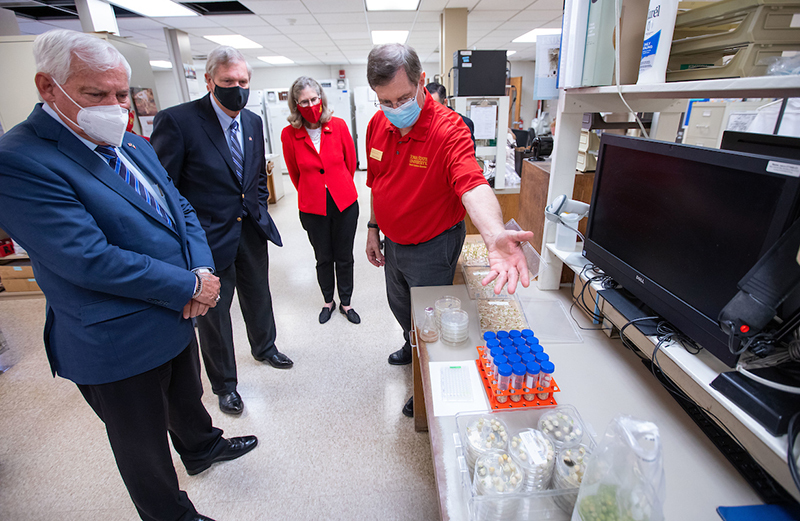
Charles Block (right), research scientist and seed health testing coordinator at ISU's Seed Science Center, provides a tour of the germination lab at the center.
